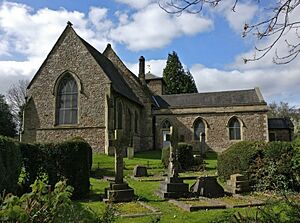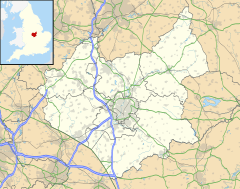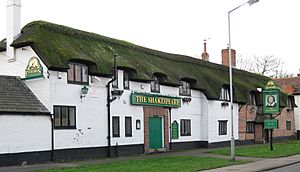Braunstone Town facts for kids
Quick facts for kids Braunstone Town |
|
|---|---|
 St Peter's Church, Braunstone Town |
|
| Population | 16,850 |
| District |
|
| Shire county | |
| Region | |
| Country | England |
| Sovereign state | United Kingdom |
| Post town | LEICESTER |
| Postcode district | LE3 |
| Dialling code | 0116 |
| Police | Leicestershire |
| Fire | Leicestershire |
| Ambulance | East Midlands |
| EU Parliament | East Midlands |
| UK Parliament |
|
Braunstone is a town and civil parish in Leicestershire, England. It's located in the Blaby district. In 2011, about 16,850 people lived here.
Braunstone is mentioned in the famous Domesday Book from 1086. Back then, it was a very small village with only a few families. It stayed small until 1925. That's when the Leicester Corporation (like the city council) bought most of the land from the Winstanley Braunstone Hall estate.
The town is just outside the city of Leicester. Part of the original Braunstone area is now inside Leicester city. This part, which has a large council estate (a neighborhood with homes built by the local government), was separated in 1935. This is why there are two "Braunstone" areas today. "Braunstone Town" is a newer name used by the Braunstone Town Council to help people tell the difference between their village and the council estate.
Braunstone Town is very close to the M1 motorway (junction 21). It's also next to popular shopping and business areas like Meridian Business and Leisure Parks, Fosse Shopping Park, and Grove Triangle. Even though Braunstone Town doesn't have its own train station, Leicester station is nearby. You can even buy special tickets called PlusBus that combine train and bus travel at a discount.
Contents
Exploring Braunstone's Past
The name 'Braunstone' likely means 'the farm or settlement of Brant'. Brant was probably a person's name.
Ancient Discoveries
The oldest human item found here is a Bronze Age axe. It's about 3,000 years old! This axe was discovered in 1893. Later, the Roman road from Leicester passed through the area.
Viking and Forest Times
It seems Vikings also settled near Braunstone. You can see this in the names of nearby places like Lubbesthorpe and Enderby. For a long time, Braunstone was covered by a large forest called Leicester Forest. This forest had small settlements and rough paths connecting them. Many of today's public footpaths might have started from these old tracks.
Braunstone in the Domesday Book
Braunstone is written about in the Domesday Book from 1086. It was called BRANTESTONE or BRANSTUN. The book describes it as having land for farming and a wood. It also mentions "socmen" (free peasants) and "villeins" (peasants tied to the land).
The land was held by Robert Burdet, who worked for Hugh de Grandmesnil. He was one of William I's most powerful barons. A "ploughland" was a large area of land, usually between 80 and 120 acres. You can see a copy of the Domesday Book at Braunstone Civic Centre.
Growth and Changes
The de Grandmesnil family was the first Lord of the Manor. Back then, the village had only 8 households. By 1299, it had grown to 24 households.
The 14th century saw outbreaks of the Black Death. We don't know how badly Braunstone was affected, but nearby Glenfield suffered a lot. Over time, parts of the forest were turned into pastures, mostly for sheep. This was because sheep farming was more profitable. By 1628, Leicester Forest was fully enclosed, meaning its land was divided into private fields. Villagers in Braunstone received payments for losing their old forest rights.
Prosperity and Modern Changes
The 18th century was a good time for Braunstone. Farmers like Abraham Compton had many animals, showing the area was doing well. In the 1820s, Braunstone was a popular place for fox-hunting. An artist named Charles Loraine Smith even painted funny pictures about it.
Braunstone remained a village until 1925. That's when the Leicester Corporation bought most of the Winstanley Braunstone Hall estate. This purchase cost £116,500.
Braunstone's population grew very quickly. It went from 238 people in 1921 to almost 7,000 in 1931! In 1935, the part of Braunstone closer to the city became part of Leicester. This area mostly has council housing built between 1925 and 1940.
Braunstone During World War Two
During World War Two, Braunstone Park was used for farming. Wheat, barley, and potatoes were grown, and sheep grazed there. The area that is now the Memorial Gardens was a military camp. First, the British Army used it, then American 82nd Airborne Division troops stayed there. After the war, because there weren't enough homes, people were allowed to live in the camp until they found permanent houses.
In the 1990s, Braunstone faced some challenges. There were higher rates of unemployment and youth groups. However, the area has continued to develop and improve.
Braunstone was also home to the main office of British Shoe Corporation from 1965 to 1999. A plaque on Sunningdale Road shows this history and its connection to the company's founder, Charles Clore.
Braunstone Town Council
The Braunstone Town Council is the local government for Braunstone Town. It's a type of parish council. The council was started in 1977.
The Town Council has 21 elected members, called councillors. They are elected for four-year terms. In 2023, Braunstone Town Council won the "Star Council of the Year" award from the National Association of Local Councils. This shows it's a well-run and effective council.
Braunstone Hall
Braunstone Hall is a Grade II listed building. This means it's an important historical building. It's located in the middle of Braunstone Park. The Winstanley family, who owned most of the land in Braunstone, built it in 1776.
The Hall was designed by a local builder, William Oldham. He used common local materials like red brick and Swithland slate. The building has a grand entrance and elegant features inside, like Classical columns and a nice staircase. Building the Hall was dangerous, and records show that a stonemason and a labourer died during its construction.
The Park and Gardens
Around the Hall, the Winstanleys created a park with a lake and gardens. They also had stables for their horses and carriages. The walled garden, which has been beautifully restored by the city council, once grew fruit trees. It was also a lovely place for the family to walk.
The Winstanley family also helped build other important buildings in the village. They hired a famous architect, William Butterfield, to design cottages for their workers in 1859. They also paid for the parsonage (a house for the church minister) in 1864 and the village school in 1867.
From School to Hotel
In 1902, some parts of the Winstanley estate were sold for new buildings. Then, in the 1930s, the Leicester Corporation bought the main estate. Braunstone Hall was first used by the Parks Department. From 1932, it became a junior school with over 600 students. In 1939, the Leicester Education Committee bought the Hall to make more changes and add an assembly hall.
The Hall was used as a school until 1996. After that, it started to fall apart. But in 2013, plans were made to restore it. Now, it's called Winstanley House and is a hotel, restaurant, and wedding venue.
St Peter's Church
The first mention of a church in Braunstone dates back to 1168. The oldest parts of the current church were built in the 12th or 13th century. It's made of limestone and has a short square tower, a nave (the main part of the church), and a chancel (the area around the altar). The roof was replaced in 1867, and some small updates were made in the 20th century. In 1937, Braunstone became its own parish, and St Peter's became the main church with its own vicar.
Arms
|






